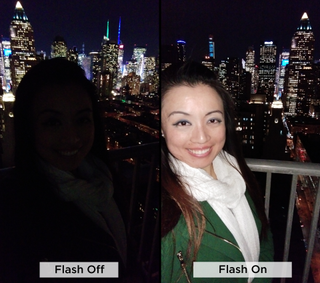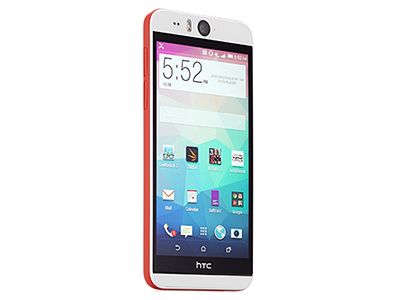Tom's Guide Verdict
Packing a 13-megapixel camera on its front and back, the HTC Desire Eye smartphone takes selfie shooting to new levels.
Pros
- +
Sharp selfie camera
- +
Good image quality from both front and rear cameras
- +
Comprehensive photo-editing app
- +
Zippy performance
- +
Powerful speakers
Cons
- -
Below-average battery life
- -
Sluggish autofocus
Why you can trust Tom's Guide
Among my friends, I am the selfie queen. But HTC's Desire Eye could give my chums a claim to my throne. The first phone to feature a front camera that's as sharp as its rear 13-megapixel shooter, the Desire Eye is designed for selfie lovers who want to snap bigger and better portraits.

We put this HTC smartphone's shooter to the test to see if it's good enough to be your primary camera. We summarize other aspects of the phone here, but for a detailed breakdown of its smartphone performance, check out the full review on our sister site Laptop Mag.
Image Quality: Good Colors and Detail
Both the front and rear cameras of the Desire Eye snapped colorful, crisp photos, particularly in bright light.
Rear Camera
My shots of a wooden hut atop a small hill in Central Park one sunny afternoon showed a vivid blue sky, green grass and orange leaves. The photo was not only attractive but also true to life: The camera did not oversaturate the muted colors of the late-fall leaves and grass. Details, such as individual tendrils adorning the columns of the hut, were sharp.

Close-up shots of a chocolate-green-tea lava cake also displayed mouth-watering detail, as individual crumbs of the cake and the oozing mix of chocolate sauce and green-tea ice cream looked tack-sharp.

Front Camera: Slightly blue
Selfies in similar light showed the same vibrancy, with my forest-green jacket and orange purse strap looking bright and accurate. The waffle-knit pattern of my gray infinity scarf was also rendered clearly, although the scarf looked a bit bluer than it actually is.

That blue cast appears in many of the Eye's selfies. The same shots taken with my iPhone 5s were warmer and truer — orange dots on my blouse were accurately captured with the iPhone, but appeared pink in the Desire Eye's photos.

Thanks to the Desire Eye's wide-angle lens up front, I could see more of myself and the background in a photo taken with the Eye than in one taken by my iPhone 5s. It was also easier to snap group selfies with the Desire Eye at a holiday party — we framed four people in the shot, with room to spare.

With the Desire Eye, I easily squeezed in my face and three displays at my work table. On my iPhone 5s, though, even getting my face and two displays in was a stretch.

The Eye's wide lens did cause some distortion, though. Objects in the corners of the picture appeared stretched. This distortion did not appear in images taken by the iPhone 5s. Although you can fit more people in a shot, it's best to keep them away from the far ends of the frame.
Low-Light Performance
The Desire Eye captured accurate colors in low light, and my shots of Midtown Manhattan at night were vivid and sharp. Building lights and edges were clear, but some details — such as clouds in the sky — got lost, although I could see them with the naked eye.

On my 36th-floor balcony at night, selfies without flash looked dark: I was merely a silhouette in the pictures. With the phone's dual-tone LED flash activated, though, subjects in the foreground were lit up and, impressively, not washed out. Buildings in the background were also clear.

Video Performance
The 1080p video I shot at 30 frames per second (the only frame rate available) showed great colors, with the red and blue in a Spider-Man impersonator's costume popping against the golden hues of Central Park. The clip stuttered as I panned across the scene, but a sequence of an intrepid dog chasing a squirrel was smooth.
A selfie video I took showing myself in front of the Central Park Zoo was similarly clear and bright, but displayed the same stuttering when I panned across a scene. The iPhone 6's cameras both delivered much smoother footage, but that device shoots at 60 fps. The Eye kept my face sharp and in focus, though.
Autofocus: Sluggish
I was frustrated by the Desire Eye's slow autofocus. The phone takes about a second to lock on and snap an image, which can cause you to miss a fleeting moment. I often found myself telling my subjects to hold still for awhile so the HTC could focus.
Shots were frequently blurry, as in the top photo, and it often took several attempts before I could get a sharp image, like the one on the bottom.


Camera App: Real-Time Plastic Surgery
With such a sharp front camera, I was worried that the Desire Eye would mercilessly reproduce every imperfection in my selfies. Thankfully, HTC's camera app packs live enhancement tools that make you look great in every photo. The first time I shot a portrait with the phone, I was so stunned that I exclaimed, "There is no way I look this good right now!"
Even without the phone's Live Makeup tool activated, my skin appeared smoother, eyes brighter and lips redder in the photo than in real life. I was so mesmerized that I ended up spending 15 minutes taking numerous selfies.

When you enable Live Makeup in the camera's settings, you get a slider on the viewfinder to toggle the intensity of enhancement applied to your face. Pull it toward the right, and ogle as you look more and more like a pop star. Your eyes grow larger, your skin gets fairer and your lips become pinker.

Although I'm not a fan of Photoshopping reality, the Narcissus in me was happy to play along. I also enjoyed my newfound popularity as people clamored to friend me on Facebook and tag themselves in pictures I took.
The camera app also offers several shooting modes: Selfie (front camera), Camera (rear), Split Capture (both cameras fire at the same time, and their images are stitched next to each other), Photobooth or Pan 360. Photobooth takes four shots in rapid succession and stitches them together in a 2 x 2 grid; Pan 360, as you may have guessed, lets you take a 360-degree panorama.
Design
The fun, vibrant plastic chassis of the Desire Eye might not be for everyone. A bright-red strip runs along the edges of the otherwise white device, which has a smooth, matte finish. Above its 5.2-inch display is the big 13-megapixel camera and LED flash, while slots for nano SIM and microSD cards sit on its left side. The right edge houses the volume, power and camera shutter buttons.
MORE: 100+ Gift Ideas for Men and Women
Display
You'll enjoy looking at your pictures and watching videos on the Desire Eye's 5.2-inch, 1920 x 1080-pixel LCD, which uses IPS technology to provide wide viewing angles.
Measuring 487 nits on our brightness meter, the Eye outshined the 402-nit HTC One M8 and the 373-nit Samsung Galaxy S5. The Eye's screen can display 98.3 percent of the sRGB color gamut, which is good, but this phone trailed competitors in color accuracy, based on a measurement called Delta-E. The Desire Eye's Delta-E score of 8 (0 is best) is notably worse than that of the M8 (5.6) and the Galaxy S5 (0.9).
Audio
The Desire Eye's dual front-facing BoomSound-branded speakers pump out powerful, crisp audio. Notching 82 decibels at top volume on the Laptop Mag Audio Test, the Eye was much louder than the Galaxy S5 (73 dB) but just a hair softer than the One M8 (83 dB).
Interface and Apps
Running HTC's Sense 6.0 software on top of Android KitKat 4.4.4, the Desire Eye's interface will be familiar to any Android user. Swipe all the way to the left, and you get BlinkFeed, HTC's Flipboard-like portal that displays news and social media updates from networks you select, such as Facebook, Google+, Instagram, Twitter and LinkedIn.
In addition to standard Android apps such as Chrome, Gmail, Maps and Drive, you'll also get a handful of AT&T offerings (like it or not), such as AT&T Locker (for backing up files to AT&T's cloud service), AT&T Mail and Mobile Locate. These options are tucked away in a folder, along with the more useful Mobile Hotspot.
Performance
It's not just the cameras that shine. The Desire Eye's 2.3-GHz quad-core Snapdragon 801 processor with 2GB of RAM offers zippy performance. The camera app started up quickly, and I snapped shot after shot in rapid succession. I was able to return to the home screen almost instantly.
The Eye delivered better results than the average smartphone on benchmarks such as Geekbench 3. Its score of 2,834 is significantly higher than that of the One M8 and the smartphone category average but a tad lower than the Galaxy S5's score.
MORE: Siri vs. Google Now vs. Cortana
The Desire Eye also offered solid graphics performance, notching 17,669 on the 3DMark Ice Storm Unlimited test. That's better than the average smartphone (10,558) but worse than the Galaxy S5 (18,024) and the One M8 (20,965).
Battery Life
You might find yourself having to find an outlet before it's time to hit the town for a night of selfie shooting. On our battery test, which involves continuous Web surfing over 4G, the Desire Eye lasted 7 hours and 20 minutes. That's more than an hour less than the average smartphone (8:30). The One M8 (8:42) and the Galaxy S5 (9:42) also lasted longer.
After an evening of shooting photos and video (I turned the phone off when I wasn't shooting), the battery meter dropped from nearly full to slightly more than half. With the phone turned on all day without making any calls or sending messages and shooting for about an hour, I had to charge the Eye once a day.
Bottom Line
Thanks to the beautiful selfies the HTC Desire Eye churns out, you're bound to become the most popular photographer in your social circle. In addition to its strong camera quality, the Desire Eye packs a vibrant display, booming speakers and capable performance in a sleek, fun body. Although I wish the phone offered more juice for longer-lasting photo sessions, those who live through their portraits will love the Desire Eye.
Cherlynn is Deputy Editor, Reviews at Engadget and also leads the site's Google reporting. She graduated with a Master’s in Journalism from Columbia University before joining Tom's Guide and its sister site LaptopMag as a staff writer, where she covered wearables, cameras, laptops, computers and smartphones, among many other subjects.




